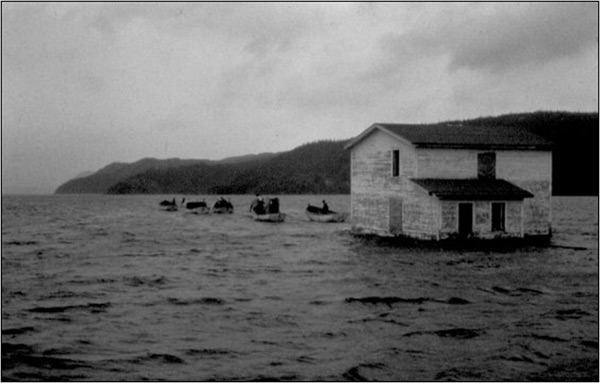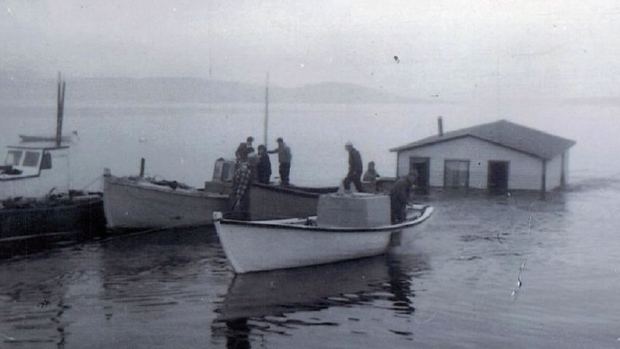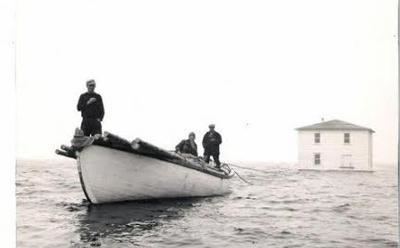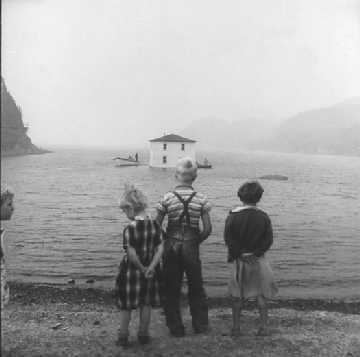 | ||
Resettlement in Newfoundland and Labrador terms was an organized approach to centralize the population into growth areas. Three attempts of resettlement were initiated by the Government between 1954 and 1975 which resulted in the abandonment of 300 communities and nearly 30,000 people moved. Government's attempt of resettlement has been viewed as one of the most controversial government programs of the post-Confederation Newfoundland and Labrador.
Contents
- Background
- Prior to 1954
- First Resettlement Program 1954 1965
- Second and Third Resettlement Programs 1965 1975
- In art
- References

Background

The history and commerce of Newfoundland and Labrador was built on the fishery and thus many small communities were established throughout the entire coastal region. Some of these communities were seasonal fishing stations and some eventually grew into communities which were very much isolated from much of the country except for water transportation or overland hiking trails. In many communities the seasonal inshore cod fishery provided both sustenance and the vast majority employment opportunities.

In the early 20th century settlement patterns and population distribution were changing due to a number of factors. Newfoundlanders began moving to larger centres such as St. John's. For example, in 1874 the population of St. John's was 30,574 and the major Conception Bay districts had a combined population of 41,368. By 1935 the population of the Conception Bay districts had increased by over 4,500 people, while the population of St. John's had more than doubled to 65,256 people.

Other parts of the island and Labrador went through major changes in resource development that affected areas outside the Avalon Peninsula. The construction of paper mills in both Grand Falls and Corner Brook drew many people from coastal towns and villages. These areas contributed to growth in other areas such as Botwood and Deer Lake. Mineral discoveries at places such as Wabush and Labrador City, St. Lawrence, Baie Verte and Buchans also contributed to the movement of people away from the outports. World War II also had a part to play when air force bases were built at Stephenville, Argentia and Goose Bay, and the booming international airport in Gander.
Prior to 1954

Prior to the start of the government sponsored resettlement program many communities were abandoned for various reasons including disease, lack of work and natural disaster. One of the earliest examples of this is the community of Garia. The community lost 3/4 of its inhabitants after they decided to move to Anticosti Island for work in 1873. The remaining residents slowly moved away and the community was abandoned in the 1910s.
Between 1946 and 1954, it is estimated that 49 communities were abandoned without government intervention. Government officials had long petitioned for a greater concentration of the population, citing many benefits. In 1953 the Newfoundland Department of Welfare offered small amounts of financial assistance to residents of 110 communities to accelerate the process which had come naturally. This became the beginning of the government assisted resettlement program for the province.
Labrador on a much smaller scale was experiencing a resettlement when the Moravian Church in the northern part of Labrador was relocating the Inuit to centres such as Hebron and Nain. Dr. Wilfred Grenfell, in his efforts to provide health and educational benefits to the people of southern Labrador and the northern coast of the Great Northern Peninsula, also helped to the centralization of populations in areas such as St. Anthony and Charlottetown.
First Resettlement Program (1954-1965)
In 1954 the provincial Department of Welfare introduced a program to encourage residents of small coastal communities to move to larger "growth centres". would pay for the relocation of all of a families belongings as well as their house to the new community. This was changed to a cash payment of $150 per family at the start of the program and gradually increased to $600 per family by the end of the program. This was a significant amount of money as the a fisherman working in the inshore fishery was generally under $500 per year. In order for a community to be eligible for assistance every member would have to agree to relocate. By 1965 the program had helped resettle 115 communities with a combined population of 7500.
Second and Third Resettlement Programs (1965-1975)
In 1965 the provincial and federal governments partnered in a new resettlement program. The new program was administered by the Department of Fisheries. Under the new program the assistance was increased to $1000 per family plus $200 for each dependant in addition to moving costs. The proportion of residents who needed to agree to the move decreased to 90% and later to 80%. A second federal-provincial agreement was started in 1970, with responsibility being shared by the federal Department of Regional Economic Expansion (DREE) and the provincial Department of Community and Social Development. Between 1965 and 1975 some 148 communities were abandoned, involving the relocation of an additional 20,000 people.
In art
The social change caused by resettlement has appeared in some works of literature and music. The song The Government Game by the Newfoundland writer Al Pittman describes the issue, with lyrics such as "It's surely a sad sight, their movin' around,/ A-wishin they still lived by the cod-fishin' ground;/ But there's no goin' back now, there's nothing to gain,/ Now that they've played in the government game." The song Out From St Leonards also describes the resettlement, noting how residents left "with their houses in tow" by physically shipping buildings to their new homes.
